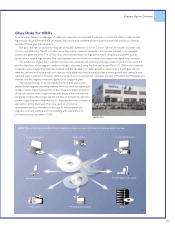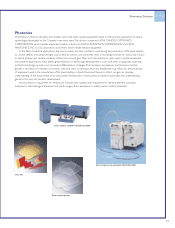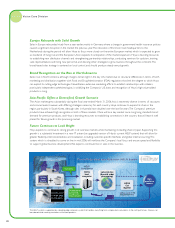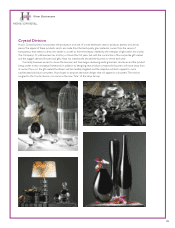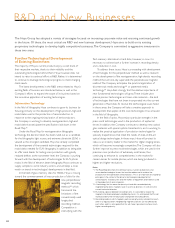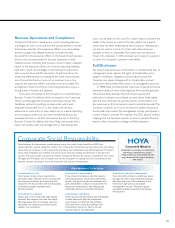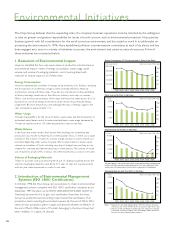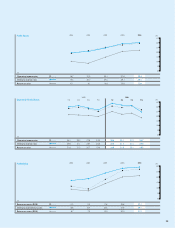Pentax 2006 Annual Report Download - page 28
Download and view the complete annual report
Please find page 28 of the 2006 Pentax annual report below. You can navigate through the pages in the report by either clicking on the pages listed below, or by using the keyword search tool below to find specific information within the annual report.
Eye Care
Manufacturers of eyeglass lenses in South Korea and China have
until recently concentrated on low-end products, but are now moving
into such middle-end products as plastic lenses with a high refractive
index. They are speeding up their drive to catch up technologically. In
response to this situation, Hoya is developing a new range of highly
functional coatings, including a new anti-reflective coating,
photochromic coatings,*5 and dirt repellent coatings. Hoya’s effort to
push ahead with the introduction of high-value-added products is also
augmented by its aspherical free form processing technologies and
other unique advantages. In addition, the Company is striving to cut
costs by creating innovative production technologies.
The need for IOLs is expected to increase significantly into the
future, in line with the growth in the number of cataract patients in
aging societies. Hoya is working to introduce an improved cartridge
injector for IOLs to greatly reduce the levels of discomfort
experienced by patients during cataract operations and further
enhance the safety of the procedure. The Company will continue to
actively engage in R&D of new medical products in the ophthalmic
field, including the development of an IOL that offers a broader range
of vision correction.
Note:
*5. Photochromic lenses change color when subjected to light, through changes to
the molecular structure while the molecular weight remains unchanged. These
lenses are used in light-sensitive sunglasses.
New Business Development
The Hoya Group actively seeks to develop or acquire a new, third
major line of business to complement its successes in Information
Technology and Eye Care. The objective is to develop a business that
leverages its proprietary technologies in a field which can be expected
to grow over the long term. The Company engages in both in-house
and collaborative R&D, and is investing in a variety of ventures with
the objective of procuring and developing new technologies that will
sustain growth into the future. This section presents several new
fields that hold the promise of taking root and growing as strong
new businesses.
Optical Communications System
Over the past several years, broadband has won acceptance quickly
both in the workplace and at home, and new services such as
video distribution have come into their own. Hoya is working on
technologies for the integration of optical parts for communications
devices, through the practical application of optical technologies. The
Company has invested in the U.S. firm, Xponent Photonics, Inc., which
owns technologies allowing for the development of highly integrated
modules used in fiber to the home (FTTH), an optical fiber data
communications service for the home that is currently experiencing
rapid growth. These technologies offer the potential to go beyond
FTTH—for instance, they can be used in connectors of high-
resolution audiovisual equipment. We will work with Xponent to
expand the range of applications.
3C-SiC
Seen from the perspective of strategies for responding to global
warming and contributing to environmental conservation,
expectations have grown for hybrid automobiles and fuel cell
powered vehicles. Hoya is developing devices that use large-diameter
3C-SiC monocrystal (based on silicon carbide), which can be
employed in power devices that are highly energy efficient at high
voltage and with low power loss. The aim is to achieve practical
applications in the automobile field, which demands absolute safety
and reliability.
Glass Substrates
Glass substrate products came into commercial production in
2006 for use in mobile phones, thanks to their superior high-
frequency characteristics, capability for minutely detailed
processing, and capacity for double-sided electrical connectivity.
Demand is somewhat limited at the moment, but Hoya anticipates
that the track record of these glass substrates will provide the
evidence it takes to motivate producers to adopt them for
ultrahigh-speed optical-electric conversion modules.
Nanoimprint Technology
Thus far, miniaturization in the semiconductor industry has primarily
helped to realize lower production costs. From the next generation of
semiconductors onward, however, huge changes in lithography
technologies will be required, and the industry is concerned about the
possibility of increased investment in plant and equipment. This has
given rise to the belief that EUV lithography, which is expected to be
the next-generation technology, may be used only for the production
of a limited range of identical devices in large numbers.
In this context, nanoimprint technology is attracting attention as a
new ultra-fine processing technology that could be used to mold
circuit patterns on devices requiring smaller production runs, at a
lower cost. Hoya is proceeding with development of technologies that
can be employed at the 50-nanometer level and below. Applications
may not be limited to semiconductor manufacture; the Company is
also considering the possibility of expanding the use of the technology
to optical applications such as light emitting devices and displays.


